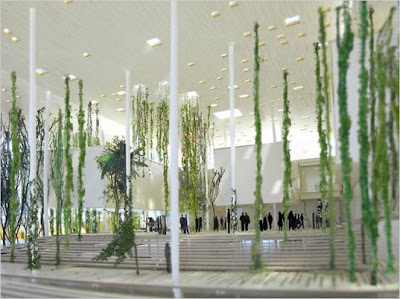
:: image via CNN.com
This reinforces the concept in an earlier post that much of the exposed surface area, particularly in urban areas is found in the building skin - and thus a good portion of the energy benefits can be realized with facade greening, particularly on buildings with smaller roofs and taller that 2-3 stories. As the adage of losing most of your heat through your head is similar to building envelope, it makes sense: Full coverage = full benefit.

:: image via Dwell
A couple of projects unveiled this week only add fuel to this trendy fire, in some inventive ways. The first is dubbed Brooklyn's first living wall at the Oulu Bar & EcoLounge which was featured yesterday on Jetson Green. According to Preston at JG, the project (Correction, 03.28.08 - I previously listed the amount of living wall as 2500 sf, which is actually the building area, not sure of total living wall coverage) has the entire front facade covered in vegetation, using what at first glance looks like the ELT Living Wall Panels and planted with a mix of sedums, iceplant and other succulents.



:: images via Jetson Green
The most striking view is the before and after - which should be required viewing for any business with a need for some alternative façadism. You can find more information and photos from designer Evangeline Dennie's website as well.


:: images via Jetson Green
The next is a more abstractly artful example of wispy tendrils of vegetation for the Miami Art Museum by Herzog and de Meuron, and is striking in illustrative form and concept. Spotted on Inhabitat, the project is: "...described as the modern interpretation of the Hanging Gardens of Babylon - an imaginative structure that bridges urban spaces, climates and cultures... As visitors move from the park into the open plaza, they will be greeted by a series of trees and columns, meant to resemble a forest canopy."

:: image via Inhabitat
No comments:
Post a Comment